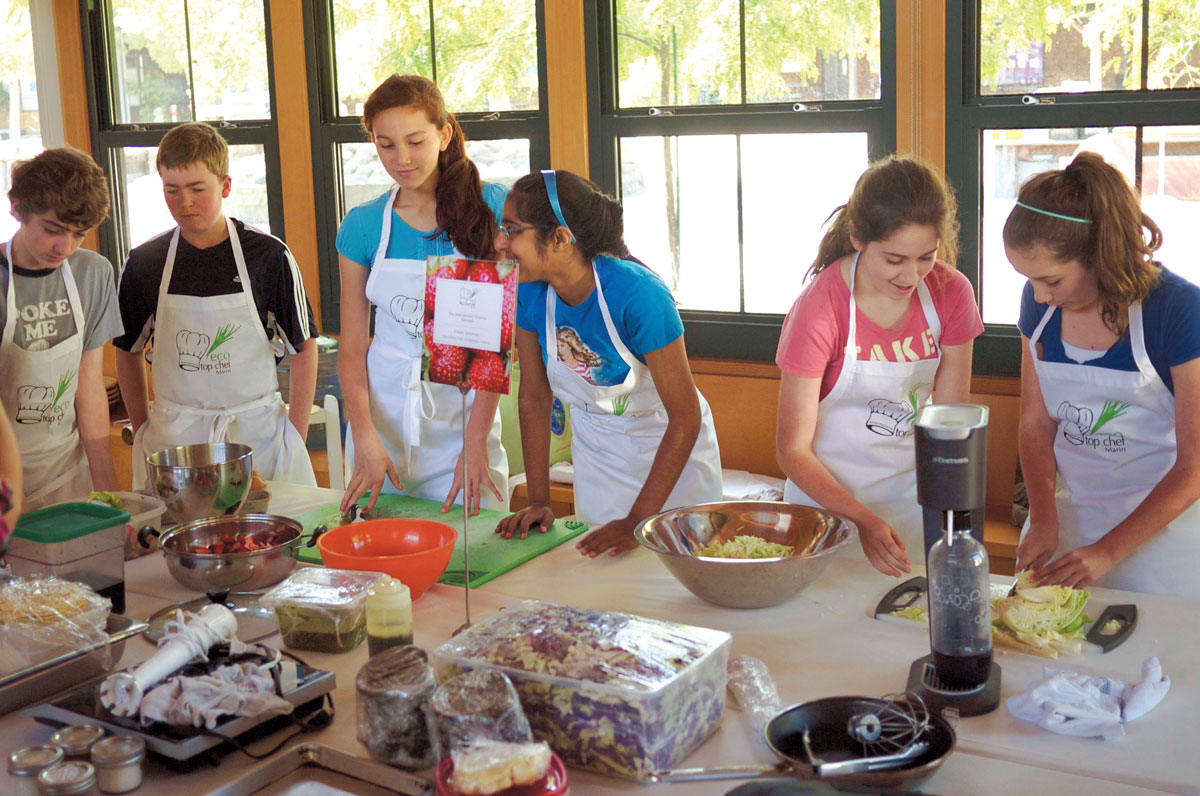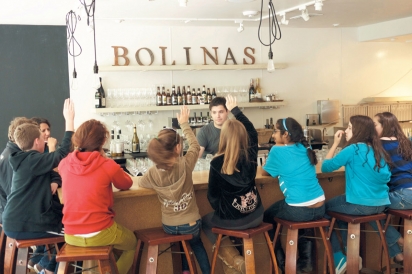Marin's Teens Battle for Title "Eco Top Chef"
Executive chef Jason Hull of the Marin Country Day School (MCDS) had already retreated behind the scenes into his own kitchen, no doubt to take stock of the massive clean-up ahead.
He had just hosted the first Eco Top Chef Marin (ETCM) finals, which had pitted his own team of eight middle school students against six other middle school teams from Marin County. In the adjacent dining hall, a crowd of 200 students, teachers, local foodies and chefs were still lined up at the buffet.
Eighth-grader Piers Deeth-Stehlin, one of Hull’s team members, bounced into the kitchen and cornered him, as if to chest bump or pound fists with his mentor, shouting, “Dude! That mac ’n’ cheese is ridiculous!”
I knew then that ETCM’s approach of pairing local chefs with kids to teach them to make healthful food choices had succeeded. The macaroni and cheese in question had been the featured entrée of the MCDS team, and at the last minute they had made a major change in their recipe, eliminating bacon and substituting cauliflower—taking a gamble with a healthier option. It may not have won them the title, but it was good. Ridiculously so, in fact.
ETCM is a wildly ambitious food education program that exists comfortably within an even more ambitious and far- reaching program that promotes environmental activism among youth: Teens Turning Green (TTG). TTG is a non- profit whose mission is to empower teens to protect themselves and the Earth from toxic chemical exposures. TTG Founder and Executive Director Judi Shils, with energy to match even the most rambunctious middle schooler, deflects praise and concedes, “Of all our programs—and we have lots of bigger national, and even international, programs—this one [ETCM] has the biggest heart.”
Kids who competed in this first ETCM were begging Shils for the chance to participate next year before the event was even over. The chefs, who, after spending all day cooking with kids, had to hustle off to gear up for Saturday night in their own restaurants, thanked Shils, as well, some with tears in their eyes. It was that much fun watching these eager young people learn how to cook.
Shils, who emceed the competition, says her favorite part was listening to the student presentations—the part where students, after presenting their food, had to stand at attention and offer their food wisdom to a panel of judges. It was a chance for the students to reflect on the two-month-long curriculum that included six after-school meetings and four field trips,
and allowed them to own terms like “organic,” “natural” and “local.” It was also the edge-of-your-seat part of the competition, where evenly matched teams fielded make-or-break questions from the judges. But I’m getting ahead of myself.
TTG had invited all of Marin’s middle schools to participate in this first ETCM. Interested students were asked to fill out a questionnaire that included a description of their “perfect” breakfast and a tabulation of a week’s worth of school menus, including brands and sources. This process may have deterred the less committed. But judging by the number of entries, Marin County teens were apparently jumping at the chance to compete in a Top Chef–style cooking contest. Tiburon’s Del Mar Middle School had 45 students apply and had to resort to a lottery to select its eight-member team.
And so their education began. Seven schools. Seven faculty mentors. Seven lead chefs. And seven weeks to get ready.
At the first meeting a student from each team drew the name of their lead chef from a hat. These kids are pretty sophisticated, so they were stoked with the lineup: Jason Hull, executive chef of MCDS; Rick Edge, chef of Balboa Café in Mill Valley; Ed Vigil, at the time the chef of Vin Antico in San Rafael; Francesco Torre from Fish. restaurant in Sausalito; Jeremy Goldfarb, chef of 123 Bolinas in Fairfax; Sol Hernandez, chef of Sol Food in San Rafael; and Norman Louie, chef of Harmony restaurant in Mill Valley.
From the start, it was clear to the chefs that these kids were passionate about food, as well as where it comes from. As for skills? A few of Hull’s team had taken a cooking class from him last year. In most cases the students’ skills were a little dicey. And their grasp on the nuances of sustainability? The give-and-take between the demands of economic profitability, environmental health and social equity? Um. Any middle schooler reading this, are you still awake? Wait. What?
It was time for the “eco” portion of the students’ education. First stop: Whole Foods Market on East Blithedale Avenue in Mill Valley. Geri Feldman, marketing team leader, usually leads store tours for younger kids, so when Eco Top Chef turned up on a field trip, she welcomed the chance to get into some serious label reading. While the term “organic” is defined by federal legisla- tion and upheld by USDA inspection, other terms like “natural” and “quality of life” are not clearly defined. Feldman explained that, at Whole Foods, “natural” means the food contains no artificial color, flavor, dyes or preservatives. Feldman told the kids that all of the food at Whole Foods is natural.
Another point of pride for Feldman is that, according to her, the East Blithedale store has more local foods than any other green grocer in Marin—“local” being defined as sourced from within a 100-mile radius of itself.
“Is local better?” asked seventh-grader Scott McCrae, from Del Mar Middle School. Yes, Feldman explained, because it reduces the environmental impact of transporting the product. If she’d had time, she probably could have listed half a dozen other reasons why local is better.
On the field trip to the Marin Civic Center Farmers’ Market, Tyler Thayer of the Agricultural Institute of Marin told the kids how he changed his diet a few years ago after receiving a cancer diagnosis and how, now that he has lost weight and eats healthy foods, he is cancer free. He also wowed the students by showing them some local produce that they had never seen before.
At the Green Gulch Zen Center and Organic Garden, students toured the farm that is nestled into a lovely ShangriLa-like valley above Muir Beach. The garden produces annual row crops free from pesticides and chemical fertilizers. In addition to a preponderance of chard and kale, there’s an heirloom orchard with apples, pears, plums and berries. The guides there explained to the kids that Green Gulch only sells its produce at a few local farmers’ markets, including the Friday market in the CVS Pharmacy parking lot on East Blithedale Avenue in Mill Valley, so if you buy some- thing from a Green Gulch stand you are sure to get it at the peak of ripeness, when nutritional value is also maximized.
After these educational trips, the real test for Del Mar teacher and ETCM mentor Norlene Jones was to encourage her team to put into practice all they’d learned about healthful eating when it came time to choose their menu. This would be tough, given a budget of only $1.35 per plate, but each team needed to prove that a fresh, locally sourced, organic school lunch was possible within the USDA per student allocation.
With their work cut out for them, and the competition only two weeks away, Del Mar’s students gathered inside the sunny 123 Bolinas with Chef Goldfarb. As the kids barked out menu ideas, the chef stood calmly behind the bar waiting for an idea that everyone could agree on.
“Sandwiches!” yelled one. “Sandwiches are boring,” said another, chin in hand.
“Tacos!” “Tacos are messy!” “Chicken!” “Chicken is totally boring.”
Chef Goldfarb smiled faintly and interrupted: “I can show you how to cook chicken that will taste better than any chicken you’ve ever had anywhere. I guarantee it.” The students looked dubious. It was Jones’s turn to interject. “I think we need to not dismiss ideas so quickly,” she said gently. “Tacos can be good. And it doesn’t have to be chicken. What about...”
“Pork!” yelled several students at once. The idea was not instantly dismissed. It was mulled over and talked around a bit. Goldfarb confirmed that he could do pork within the budget, and everyone finally agreed: pulled pork tacos. Jones and Goldfarb looked relieved.
Chef Ed Vigil and the Martin Luther King Jr. Academy team worked out their menu during the Green Gulch tour. Being surrounded by all that chard, plus the chard they knew from their own school garden, must have inspired them. Vigil says he was shocked by the $1.35 budget. The lunch had to satisfy all the sourcing and cost conditions, but it had to appeal to kids, too. The MLK team’s solution? Grilled flatbread panini with fava beans and chard. Vigil knew when they finally got it right: “The kids were so enthused that you could hold it in your hand and go to class.”
On the night before the competition many of the chefs were up half the night, gathering equipment, figuring cost break-downs per serving and furiously emailing back and forth with Shils to make sure they had all their ducks in a row. Starting at 8:30am on the big day, students arrived at MCDS to find the chefs already installed at prep tables and ready to put them to work. Chef Hull is used to having kids in his kitchen, but 56 kids at one time? “It was controlled chaos,” Hull said.
Hours later the first-up MLK team stood nervously at attention in their aprons and toques and watched the faces of the esteemed judges, all along the elegantly set head table, as they chewed, swallowed and savored. In their presentation, the students explained how they had sourced the lettuce, fava beans, chard and onions from their own school garden. Then it was time for the judges’ questions.
“What sweetener did you use in your lemonade?” one of the judges asked. There was a stricken pause. I was feeling their pain the way you do for kids in a spelling bee. After a whispered consultation between team members, a girl said “cane sugar.” The audience breathed a sigh of relief.
Subsequent teams had an advantage. They could see that sweetener question coming. As the afternoon progressed, teams offered up the following alternatives to cane sugar: “organic cane sugar,” “organic brown sugar.” And then came the game-changer: “agave syrup!”
But the best was yet to come. MCDS took the floor with the aforementioned mac ’n’ cheese. The way the winds were blowing they were surely relieved to have had the foresight to scrap the bacon. Nothing could have prepared them, however, for what turned out to be the toughest question of the day: “If you had to choose your food for only one characteristic, what would you choose: fresh, local, or organic?” asked one of the judges.
At this stage of the competition, I should mention, the kids were conspicuously without adult representation. Their mentor was back in the kitchen under a mountain of dishes (think Patches O’ Houlihan in DodgeBall). Heroically, and without blinking an eye, eighth-grader Deeth-Stehlin said, “Local. Because if you live in Marin, most likely that means organically grown. Also local is better for the environment because the food doesn’t have to be flown or trucked anywhere. And it’s better for you, because it’s picked ripe.”
In the end, Kent Middle School won third place with their all-vegan menu—a risk that had apparently paid off. Second place went to Del Mar Middle School and their pork tacos. The judges noted that all school menus feature tacos at least once a week, and tacos could be made by schools even without a full kitchen. First place went to Martin Luther King Jr. Academy for their food and the huge commitment they’ve made with their school garden.
A couple of weeks after the competition, the students from Del Mar presented Chef Goldfarb with a handmade card and an envelope stuffed with euros to take with him to Spain on his upcoming vacation, so that he can have a meal on them. Each student had signed the card and written a little note. One girl had written, “Thank you for being our shef.” Oh, well. It wasn’t a spelling test. This was something different.
Cathy Petrick, a Marin mom, loved writing this article, as it pretty much combined all of her passions: kids, writing and food. It also allowed her to team up with her good friend, photographer Shelly Peppel.








